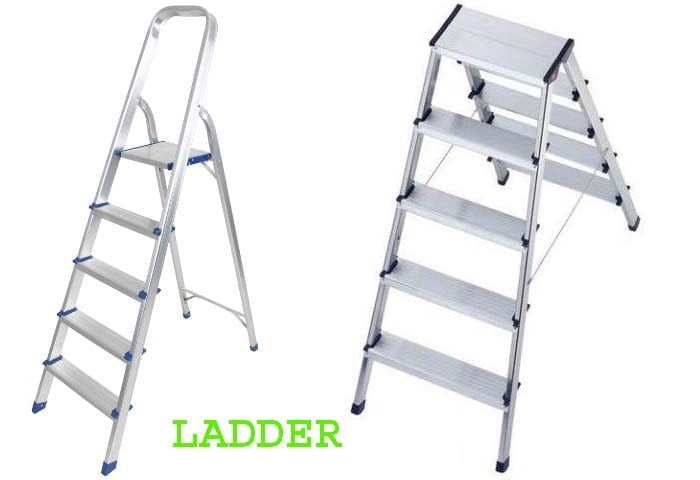All ladders shall be designed to carry their intended load safely. Side rails of metal ladders shall be of sufficient cross-section to prevent excessive deflection in use. Slip-resistant shoes, lashing or other effective means shall be used to avoid the danger of slipping. Not using ladders where required is a common cause of serious accidents. Men climb on machines, equipment, boxes, barrels, etc., to get access to places above the floor and thus get involved in accidents. Ladders should rest on firm ground and their top should extend at least 1m above the place of landing. Climb using three points of contact i.e two legs and one hand.
Table of Contents
Types of ladders
- Stock Ladders:
- Step Ladders:
- Extension ladders:
- Trestle Ladders:
- Built-up Ladders (Fixed Ladders):
Stock Ladders:
- The overall length of stock ladders shall not exceed 10 M.
- The width between side rails at the base shall in no case be less than 290 mm for ladders up to 3 M in length. In the case of metal ladders, metal rungs shall be made of solid round steel rods or steel pipe and securely fastened to the side rails by riveting, bolting, or welding.
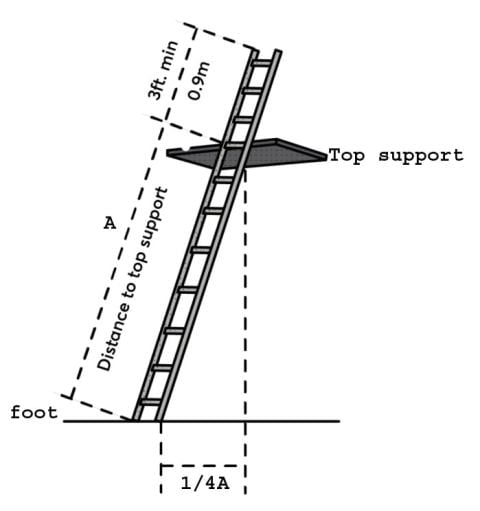
Step Ladders:
Where there is no suitable facility to lean the ladders, a step ladder should be the right choice. Step (Swing back) ladders are generally provided with a convenient platform and a handrail at the top.
- The overall height of step ladders shall not exceed 6 M.
- Ladders shall be provided with an automatic locking device or spreader to hold them in an open position.
- The maximum width between side rails at the top step, inside to inside, shall be not less than 300 mm with a spread of 25 mm for each 300 mm of the length of the spread ladder.
Extension ladders:
- The overall length of the extension ladder shall not exceed 18 M.
- The sliding section shall not exceed two in number.
- Locks and guides shall be of such design and construction as to make the extension ladder equal in strength to a ladder of equal length constructed of continuous side rails.
- When using an extension the overlap of any two sections should be as follows:
- Closed length of less than 5 M – 11/2 rungs
- 5 – 6 M – 21/2 rungs.
- Over 6 m – 31/2 rungs.
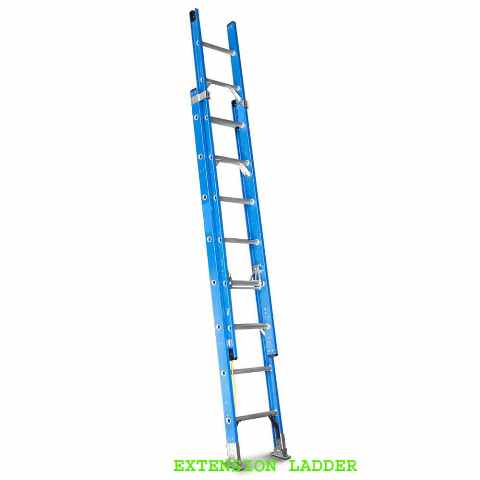
Trestle Ladders:
- Trestle ladders shall not exceed 6 M in length.
- The sections shall be so hinged at the top that when the ladder is spread, they form equal angles with the base.
- The rungs shall not be less than 30 mm in diameter shall be spaced not more than 450 mm apart center to center.
- The minimum distance between side rails of trestle ladders shall be not less than 300 mm.
- A locking device or spreader shall be provided to hold the front and back sections securely in an open position.
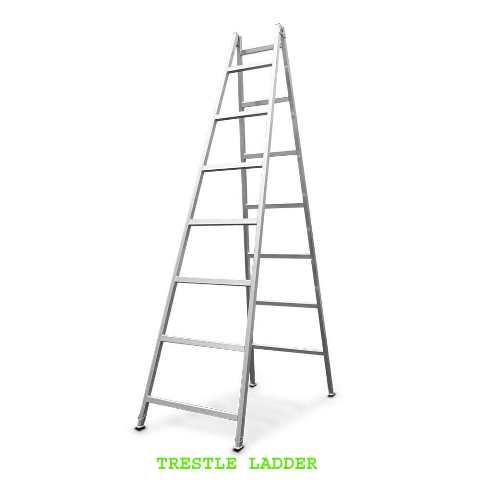
Built up Ladders (Fixed Ladders):
- All surfaces of the ladder shall be planed, free of splinters, and the edge of handrails used shall be beveled.
- Rung spacing shall be uniform and not over 300 mm on centers. Rungs shall be recessed at least 12 mm into rails/stiles.
- When height exceeds 9 M, a landing platform to be provided.
- Other dimensions of the fixed ladder shall conform to the standard.
- The top and bottom of the built-up ladder shall be securely fastened to the structure.
- It is necessary to provide a crinoline for ensuring the safety of the user or a suitable fall arrester should be used.
In the fall arrester, a slide runs smoothly up and down a steel cable fitted along with the center of the ladder. The slide is attached to the user’s belt by a chain. The slide moves up and down the cable as long as the user climbs or descends at the normal speed. If the user falls, the abrupt pull on the slide causes it to catch on the cable and thus the fall is arrested.
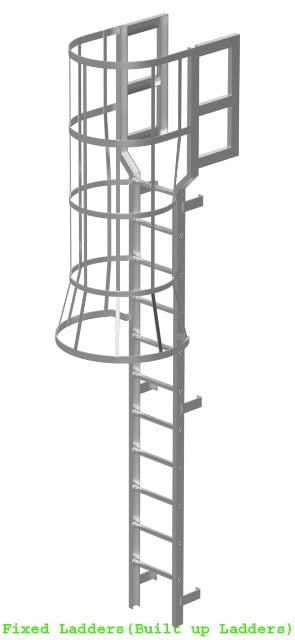
Ladder Inspection Check List
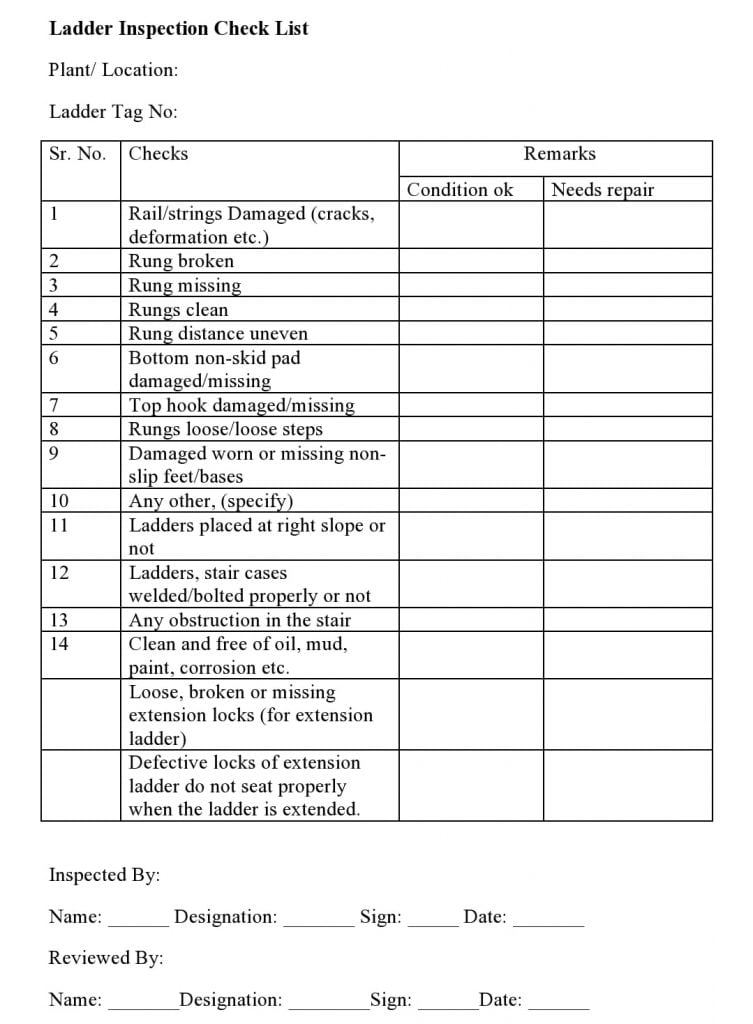
Note-Any defects to the ladder must be reported and the ladder removed from use and marked with a tag to ensure further use is prohibited. All repair work to ladders and steps may only be carried out by a competent person.
- Before use, all ladders shall be tested for a load test. They shall have not only adequate strength but rigidity as well.
- Metal ladders shall be inspected at least once in three months and all parts checked for wear, corrosion, and structural failure.
- All ladders shall be carefully inspected if incidentally dropped or otherwise damaged in use.
Ladder angle rule
The four-in-one rule ensures you are placing your ladder at the right angle. Simply say, you should set your ladder by maintaining an ideal ladder placement ratio of about 75 degrees angle to the ground. You can achieve this safe angle by following the 4 to 1 rule for a ladder placed against a vertical support wall. This principle is about the angle you use when you set up your ladder for a job.
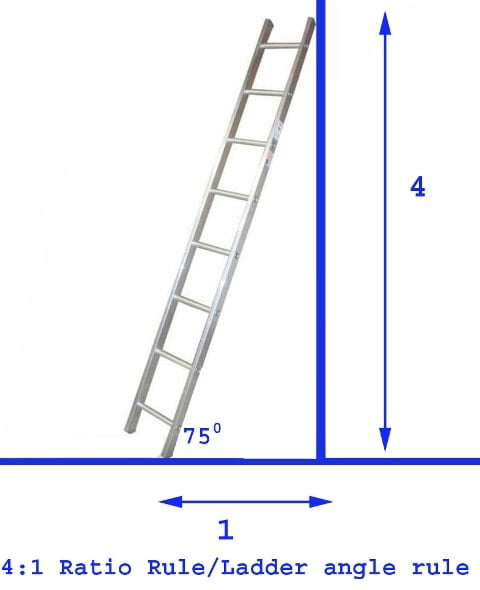
4 to 1 ratio/ rule
According to this, for every four-unit of vertical heights that you want to climb, the ladder feet/ base should move one unit away from the wall that creates a 75 degrees angle.
That means, for every 4-feet (or meter, etc.) of height you want to climb up, you should move the ladder feet/base one foot (or meter, etc.) away from the bottom end of the support wall. As a result, the bottom end of the ladder will create a 75-degree angle with the ground.
Example of ladder rule
If the ladder meets the wall at a point that’s exactly 4 meters off the ground, the foot of the ladder should be positioned precisely 1 meter away from the wall. And If the ladder reaches 8 meters off the ground, place the bottom of the ladder 2 meters back from the wall.
Ladder Inspection Tag
Ladder Inspection Tag is a plastic tag that is easy to attach to your ladder to ensure your ladders are regularly inspected. Ladders have ID numbers and have the ability to record inspection dates and signatures by safety staff. Ladder Tags easily attach directly onto ladders with cable ties. Prevent accidents or harm to users in the workplace by keeping up with regular ladder inspections using ladder inspection tags. The writable surface of the tags resists dirt, grease, and moisture.
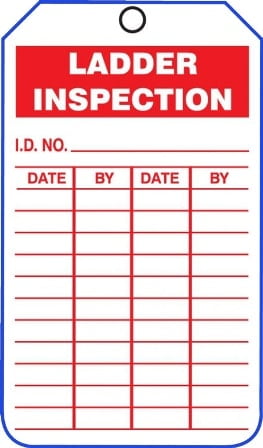
Ladder Safety:
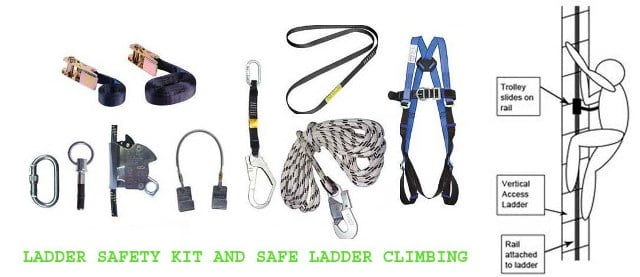
Ladders should be carried always with the leading end at least 2 m above the ground. Long and heavy ladders should be carried by two or more persons. The ladder is the safest and easiest to climb when it is at an angle of about 75° to the horizontal. The portable ladder should not be more than 20 ft long.
- Ladders leading to landings, walkways, or working platform shall extend to at least one meter above the landing and shall be secured at the upper end.
- The ladder shall be placed on a firm, level ground. It shall be provided with slip-resistant feet or someone shall hold the ladder so that it does not slip. As a further precaution, the ladder shall be placed at a slope of 1:4.
- If the use of a ladder is essential during strong winds, it shall be securely secured in position.
- No ladders shall be placed against windowpanes, or placed in front of doors opening towards it.
- When ascending or descending, the user shall face the ladder, use both his hands and place his feet near the ends of rungs than the middle.
- The user shall always maintain three-point contact for safety.
- No ladder having a missing, defective rung or one which depends for its support solely on nails, shall be used. Defective ladders shall be promptly and properly repaired or replaced.
- Hand tools and objects shall not be carried in hands while climbing up or down. Waist bags shall be used for this purpose.
- Ladders made of metal/conductive materials shall not be used in the vicinity of overhead electrical lines.
- Ladders should not be used as guys, braces, or skids or for any other purpose for which they are not intended. They shall not be used in a horizontal position as runways or cross over.
- Ladders shall not be spliced to increase the height.
- Use of items such as a chair, barrel, or box as a makeshift ladder shall not be permitted.

